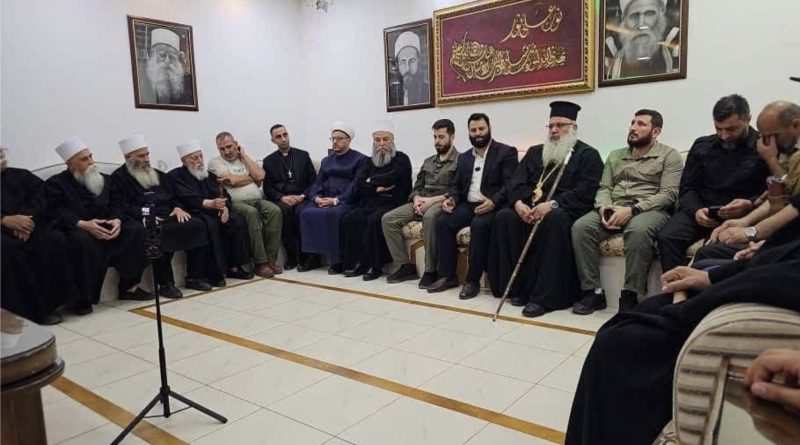Hijri’s Druze Militias and the Misinformation Machine Behind Syria’s Southern War
Damascus — In the arid hills of southern Syria, the province of Suwayda—a historical stronghold of the Druze minority—has been engulfed in one of the most chaotic and complex episodes of conflict in recent years.
What began as a local criminal dispute has now escalated into a multi-layered confrontation involving sectarian militias, Syrian government forces, Israeli airstrikes, and competing Druze factions.
Over five days of relentless violence, more than 100 have been killed and hundreds more injured. Yet, beneath the fog of war, a clearer pattern is emerging—one that reflects the geopolitical fault lines running through Syria and the region at large.
A Spark That Ignited a Firestorm
The violence erupted on July 11, when Bedouin gunmen ambushed a vegetable truck on the Damascus–Suwayda highway, assaulting the Druze driver and stealing his goods. The following day, Druze militias retaliated by kidnapping eight Bedouins, triggering a tit-for-tat spiral of abductions that quickly deteriorated into full-blown armed clashes.
Although such conflicts between Bedouin clans and Druze militias have simmered for years—largely over control of drug trafficking routes, weapons smuggling corridors, and disputed lands—this incident unleashed an unusually brutal wave of violence.
By July 13, mediation efforts by local notables collapsed. Armed clashes intensified in western rural Suwayda and in the provincial capital. In just 24 hours, over 30 were killed and nearly 100 injured. Bedouin areas were besieged while Druze villages were shelled in retaliation.
Until this flare-up, the Syrian government had largely kept its forces out of Suwayda, honoring an uneasy power-sharing arrangement with local Druze leaders. But as lawlessness spiraled, Damascus deployed military and Interior Ministry units to reassert control.
The response from Druze militias was swift and brutal: ten government soldiers were ambushed and executed, while eight others were paraded in humiliation before reportedly being killed.
That move triggered direct Israeli involvement. On July 14, Israeli drones began striking Syrian military convoys—first armored vehicles, then Interior Ministry trucks. The strikes coincided with the Syrian army’s ground operations in Druze-dominated areas and appeared to provide air cover for anti-government Druze factions.
As fighting intensified, a ceasefire was declared by Suwayda’s Druze, Christian, and civil council leaders. But within half an hour, Hikmat al-Hijri, a powerful Druze cleric, rejected the agreement and called for renewed fighting. Almost immediately, Israeli airstrikes resumed—this time across Suwayda city and beyond.
Power Struggles, Foreign Backers, and the Drug Trade
At the heart of this crisis lies Hikmat al-Hijri, spiritual leader of the Suwayda Military Council (SMC)—a faction founded after Assad’s weakening in 2012 and composed of former regime generals. The SMC has long been suspected of controlling large segments of Syria’s Captagon, heroin, and crystal meth trade, which serves as a lucrative shadow economy for armed groups.
Hijri’s repeated rejection of ceasefire efforts has angered rival Druze leaders. Sheikh Yousef al-Jarbou accused him of seeking to monopolize Druze leadership, while Laith al-Balous condemned him for destabilizing Suwayda under the influence of “subversive elements.”
The extent of Israeli coordination with Hijri’s faction is significant. Israel has traditionally struck targets in Syria to counter Iranian and Hezbollah entrenchment near its northern borders. However, its active support of a local militia implicated in narcotics and rebellion raises questions about Tel Aviv’s evolving strategy. Rather than merely deterring Iran, Israel now appears to be empowering anti-Assad factions that could help divide and destabilize southern Syria—a dangerous gamble that risks dragging the region into deeper chaos.
By July 16, Syrian government forces managed to take control of Suwayda city and Qanawat, Hijri’s stronghold. In retaliation, Israeli airstrikes expanded to Damascus, even hitting areas near the Presidential Palace and Syria’s Defense Ministry, killing at least three.
Meanwhile, the United States began mediating what became the third ceasefire attempt in 36 hours. The framework remains largely unchanged: government forces withdraw, local Druze security handle internal policing, and the Interior Ministry maintains nominal authority. Still, Hijri rejected it again, and Israeli strikes followed almost instantly.
The timing of these airstrikes—immediately after each ceasefire rejection—points toward a troubling synergy between Hijri’s tactical decisions and Israel’s military actions, amplifying the conflict and weakening Syria’s transitional government.
Beyond Suwayda: A Microcosm of Syria’s Collapse
While the Suwayda conflict is often described as sectarian—Druze versus Bedouin, or Druze versus Sunni Arab communities—it is just as much about economics and influence. The province is located on key southern smuggling routes leading into Jordan, Iraq, and the Gulf, and control over these routes is a high-stakes game. Notably, on July 15, the Jordanian military clashed twice with drug smugglers crossing over from Suwayda, reflecting the conflict’s transnational dimensions.
At the same time, the information war around Suwayda has become as intense as the conflict itself. Social media has been flooded with sensationalist claims—massacres, organ mutilation, women and children burned alive—all of which independent monitors like SOHR and other long-standing observers have debunked. Verified casualty figures suggest that combatants make up over 75% of the dead, with 6–8% being women and children.
What could have been resolved diplomatically has instead become a case study in how local power struggles, war economies, and foreign interventions intersect. A ceasefire brokered 48 hours ago might have prevented much of the bloodshed. But Hijri’s rejectionism and Israel’s airstrikes have thrown fuel on a tinderbox.
As of now, Suwayda’s future remains uncertain. If the ceasefire holds, the province may cautiously rejoin Syria’s transitional framework. But if Hijri continues to resist and foreign powers persist in exploiting local divisions, Suwayda risks becoming a permanently destabilized zone, threatening Jordan’s security and complicating Syria’s fragile peace process.
Ultimately, Suwayda illustrates the broader tragedy of post-war Syria: a nation where governance has eroded, warlords thrive, and every local conflict becomes a proxy battlefield for regional powers. Peace here won’t be achieved by airstrikes or militias. It requires a new social contract—rooted in accountability, disarmament, and regional diplomacy—to prevent yet another province from sinking into permanent instability.


